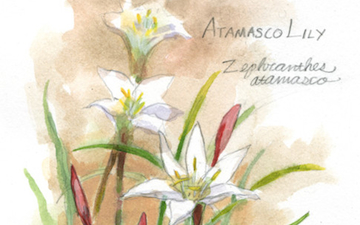Zephyranthes atamasca, commonly known as the Atamasco Lily or more generally a Rain Lily, is native to the southeastern United States. It grows in swampy forests and coastal prairies, preferring acid boggy soils rich with leaf mold. Following the appearance of broad, grassy leaves in early winter, they bloom in March or April.
Its native range extends from Florida north to southern Virginia and west to Mississippi.[1]
(From Wikipedia.org, October 29 2010)
– – –
Leaf blade shiny green, to 8 mm wide. Spathe (2–)2.2–3.2(–3.6) cm. Flowers erect to slightly inclined; perianth mostly white, sometimes tinged or veined pink, more so with age, funnelform, (5.5–)6.6–9(–10) cm; perianth tube green, (0.8–)1–2(–2.1) cm, increasing in diam., less than 1/4 perianth length, ca. 1/2 (1/3–2/3) filament length, ca. 1/2 (1/3–3/4) spathe length; tepals usually reflexed; stamens diverging, appearing equal; filaments filiform, (2.9–)3.2–4.4(–4.7) cm; anthers 3–6(–8) mm; style longer than perianth tube; stigma 3-fid, exserted more than 2 mm beyond anthers; pedicel (0–)0.4–1.6(–3.4) cm, usually shorter than spathe. 2n = 24.
(From Missouri Botanical Garden via The Encyclopedia of Life, October 29 2010)




